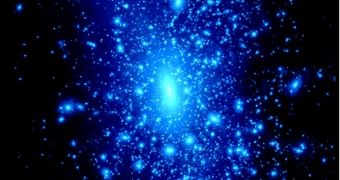We mostly view the universe as a regular structure filled with matter and light in every direction, while in fact it is anything but that. The universe is a cosmic mess, with galaxies randomly placed and linked together by filaments of matter some billions of light-years long. Forget about light! Only four percent of the matter in the universe is actually visible, meaning it is lit by light coming from the neighboring stars, including the stars themselves.
It is currently believed that more than 85 percent of the whole mass of the universe is represented by intergalactic matter in the form of filaments linking galaxies together, consisting of dark matter. Dark matter is not actually dark, instead it is called that way because it hasn't been observed yet , although there are clear evidence that it exists.
It is extremely hard to study the universe and understand the processes which take place in it, taking into consideration that more than 90 percent of it is invisible in the electromagnetic spectrum, used as a primarily tool to observe it. Astronomer Rodrigo Ibata from the Observatoire Astronomique de Strasbourg in France proposed that the cosmic filaments are some sort of mean to exchange matter throughout the universe, from a celestial body towards the other.
In order to prove the existence of the predicted cosmic filaments and the exchange of matter between two large structures such as the galaxies, the ESA has scheduled the launch of the GAIA spacecraft the would make detailed measurements of the distances between more than a billion stars and their motions, to determine if intergalactic matter filaments are present in the vicinity of our galaxy. Ibata argues that such filaments may play a key role in the formation of galaxies.
Nevertheless, even if instruments such as the GAIA spacecraft would be currently operational, we wouldn't be any farther from the point we were a month ago, since the massive amount of data the satellite would send back to Earth can't be efficiently processed with the computing technology these days. A second problem eventuality would be the question whether we could learn something new about the universe we live in or even comprehend the processed information.
According to Claude-Andre Faucher-Giguere, one way of understanding the processed data would be to embark in a process of comparing it with observations made by astronomers, in order to conceive the best theoretical image of the universe.
Most of the observations currently made in the visible universe are mostly made in the optical spectrum but have been lately extended to the whole electromagnetic spectrum, such as radio, infrared, ultraviolet, gamma ray, and x-ray wavelengths.

 14 DAY TRIAL //
14 DAY TRIAL //